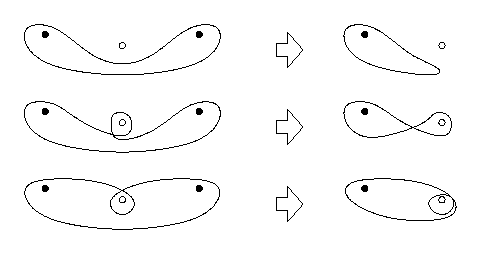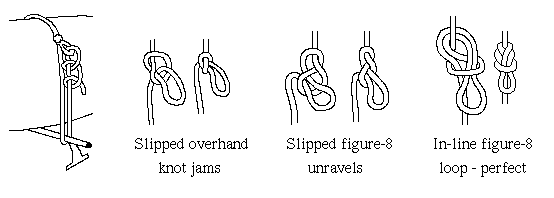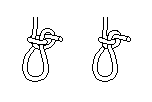Knotty topics
Knot physics --
The winding number --
The trucker's hitch --
An unnamed loop --
Links
Knot physics
There are a number of web sites dedicated to knot tying and some about knot
theory, but none (to my knowledge) that tries to connect the two. Since it is
the subject of physics to describe real-world phenomena with mathematical
means, this can with some justification be called knot physics.
Take for instance identifying common knots with in the mathematical
classification. Mathematical knots are tied on a closed loop, while most knots
in the real world aren't - most of them would be impossible to tie that way.
To compare knots to the classification, one has to join the ends of the rope
after tying the knot.
Those knots that can be tied "in the bight", ie without access to the
ends of the rope, could also be tied in a loop of rope without cutting and
rejoining it. Therefore all of them are equivalent to the unknot, the
unknotted loop. Among them are the sheep shank, the boa and the constrictor
knot and many loops and hitches. Two further knots whose classification is
well-known are the overhand knot (trefoil to mathematicians) and the figure-8
knot. The following table contains a few more:
The trucker's hitch is a bit of a speciality. One can choose one of several
loops to tie it, one can slip the loose end through the loop from back to front
or from front to back, and including the half hitches further complicates an
already complicated knot. I will do without the half hitches and just tie the
loop and join the ends of the rope after putting one through the loop. There
remain two versions for each type of loop. Here's the list of the trucker's
hitch variants I tried out:
| with slipped overhand knot | 62 or 63 |
| with slipped figure-8 knot | 76 or 77 |
| with in-line figure-8 knot | 76 or 945 |
It gives me heart that the variant I use (see below) is the most complex of them - it is quite
obviously superior ;).
Then there are knots for joining ropes together, called bends. After joining
the two ends of both ropes, they can be classified as links.
Since I first did these classifications, the task has become rather easier.
There is a classification web
application at the Indiana University's KnotInfo site
at the Indiana University's KnotInfo site which works at least for prime knots. Otherwise you have
to look at a knot
table
which works at least for prime knots. Otherwise you have
to look at a knot
table and transform your knot until you can match
part of it.
and transform your knot until you can match
part of it.
Belay stations, the winding number, and links
If you find yourself at a belay station in the middle of a rock wall where
there are two bolts which you want to use both for redundancy, you never secure
yourself as shown on the left-hand side of the picture below. (And
incidentally, you don't do a dangerous sport like rock climbing unless and
until you have learned it from an experienced instructor. Reading web pages is
definitely not enough.) Rather, you twist the upper part of the webbing into
an additional loop as shown on the right-hand side and put the karabiner linked
to your climbing harness through it.

The reason is perfectly clear to any topologist: On the left, the winding
number of the webbing loop with respect to any point of the carabiner is zero,
while on the right, it is one with respect to the point where the carabiner
passes through the small loop. In the language of knot theory, the webbing and
the carabiner form the unlink 021 on the left, but the
link 221 on the right. In the language of rock climbing,
that means that if you forget the additional twist and one of the bolts fails,
you have a problem.
One might think that it doesn't make a difference to twist the webbing into a
loop towards rather than away from oneself. That would be no catastrophy, but
it is not quite the same: The winding number is now two, and the link
421 is formed. The upshot is that the webbing wraps
around the karabiner twice, which creates a bit of a muddle should one bolt
fail. Therefore it is not usually done that way.
Here is an illustration of how to read off the winding number, including a
sketch of the Murphy scenario. Identifying the link classification number
requires a table of links (such as one of
these ) and a little spacial imagination.
) and a little spacial imagination.

My variant of the trucker's hitch
I've been using the trucker's hitch frequently to fasten kayaks on roof racks
and found part of it - the loop - impractical. As the width of the load (ie
the number of kayaks) varies, one has to untie and retie it in a different
position. Haven't the countless truckers and knot book authors noticed that
the slipped overhand knot which customarily forms the loop is near-impossible
to untie once it has been used for some time? Ok, the problem doesn't occur if
you undo and retie the knot every time you use the roof rack, but who does?
I've searched the web for a different version but all knot sites display it
with either the slipped overhand knot or (a few) with the slipped figure-8
knot.
The slipped figure-8 knot doesn't jam but has some problems of its own - it
gets untied easily if one pulls the lower end of the rope too much. One day I
came across the in-line figure-8 loop at the Knot Knowledge site (which has now
vanished). It doesn't jam, nor does it untie itself when one pulls the hanging
part of the rope. All parts of the rope curve towards the direction of their
load along gentle loops. This seems to be a very strong knot.
It has some slight disadvantages. It is tightened mainly by pulling the
standing part (ie upper part) of the rope, which means it will end up lower
than where you started tying it. You can't untie it just by pulling the
hanging part. Besides it is not easy to tie one-handed. This is sometimes
necessary for making the loop some way up the rope on top of a large van.
Being right-handed, I tie the mirror-image of the one from Knot Knowledge, as
shown below.

An unnamed loop

This loop serves as a decoration in a restaurant in the baltic spa of
Kühlungsborn. I have got no idea how widely known or used it is, but have
found it nowhere else. In fact it doesn't even seem to be in the Ashley Book
of Knots, which would mean it's probably been brought to us by aliens (or else
I didn't look closely enough). It seems to be easy to untie and rather
insecure, but is strong and doesn't jam when pulled. Its mathematical
classification is 51.
Knot links
- Notable
knots: quality instead of quantity; some well-known, some near-unknown
knots, all exceedingly useful
- Two knot theory sites: the KnotInfo site at Indiana
University has a knot drawing generator and can identify knots, and the Knot Atlas offers
tables of knots (up to 10 crossings) and links
- The International Guild of Knot Tyers is
probably the best authority on knots worldwide; its forum contains discussions
of many advanced topics
- This site presents a
selection of useful knots and photographs of how to tie them, also downloadable
as an archive
- Animationen und viele Informationen über gängige Knoten bei klabautermann.de (animated knots)
- Three large knot sites:
Knots on the web,
netknots.com
and realknots.com
TOS / Impressum





 (for neckties)
(for neckties)




 (really a hitch)
(really a hitch)


